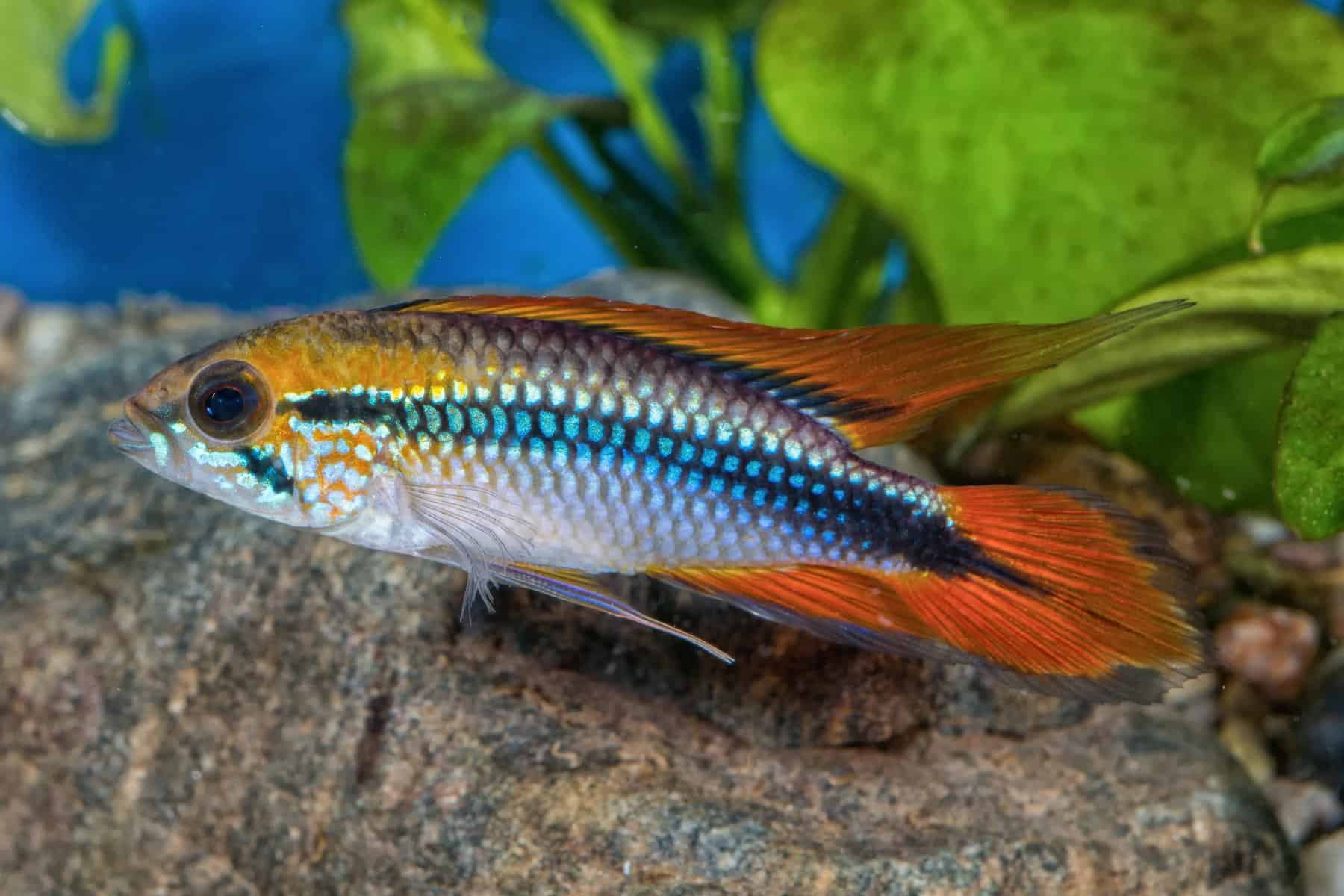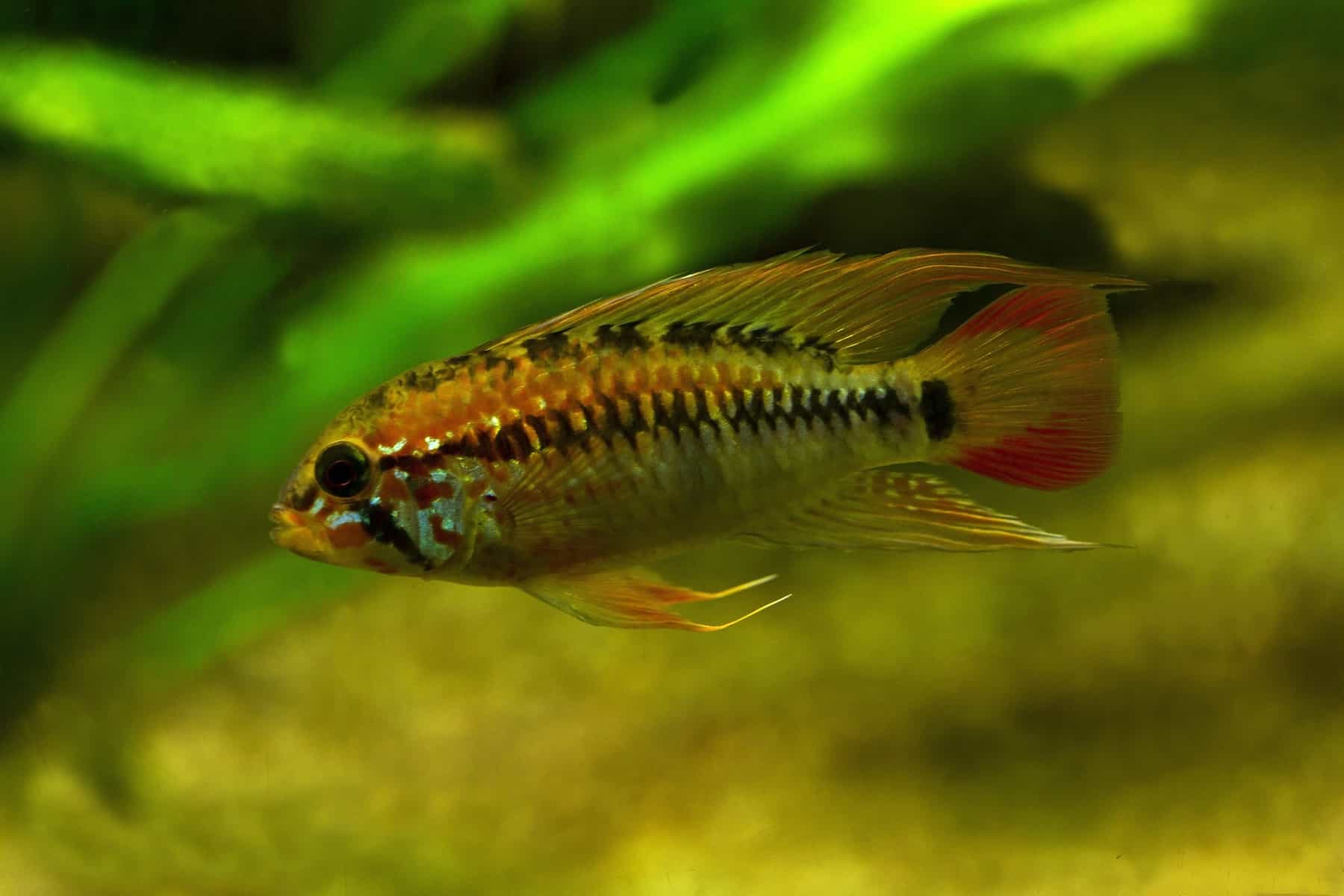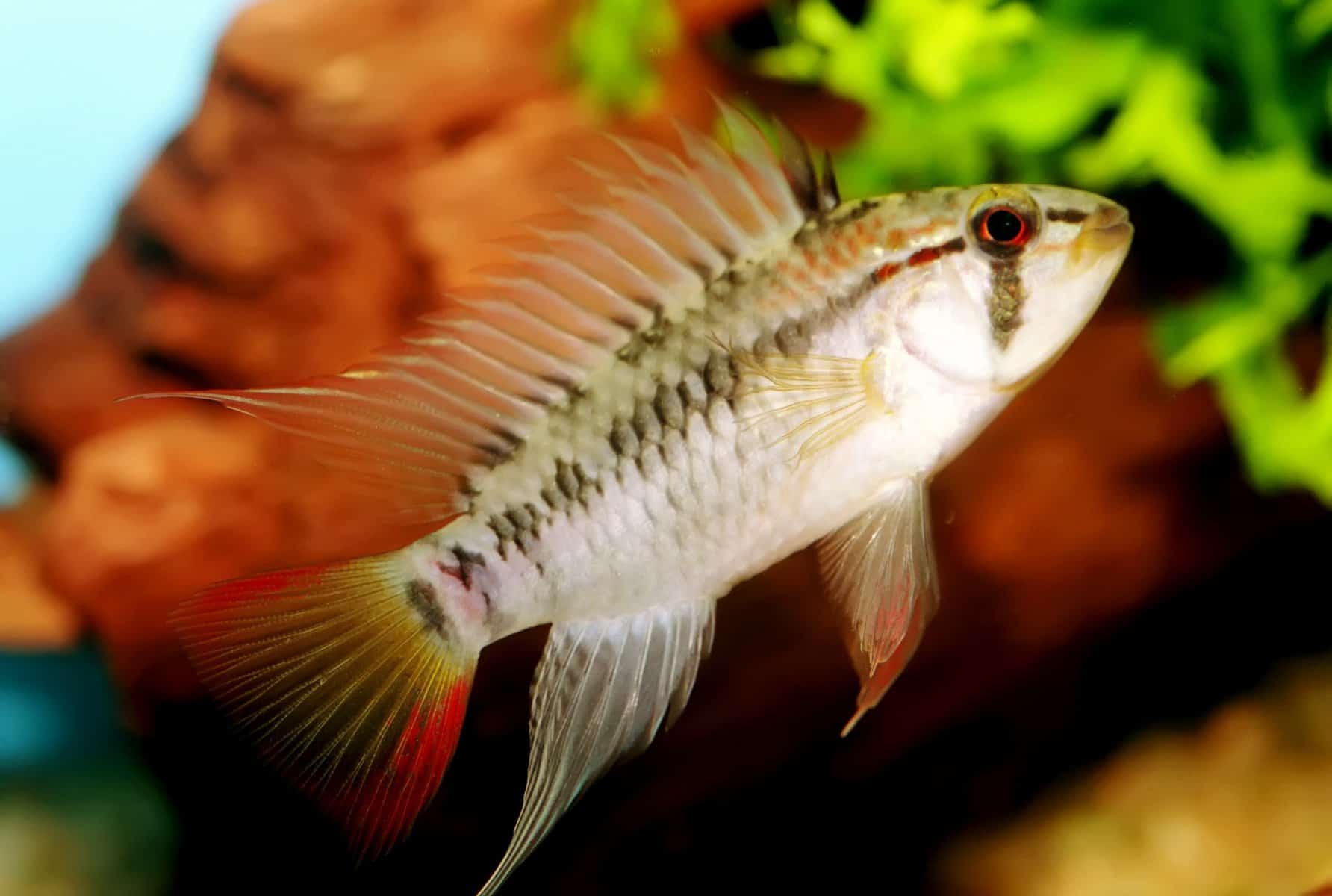[ad_1]
Apistogramma or “apistos” are one of the most popular tropical freshwater fish species in the hobby!
Apistos are more commonly known as dwarf cichlids. These are small beautiful fish that are a great choice for experienced aquarists. Even better, apistos come in a whole range of different species.
This guide provides an overview of these charming fish including the most popular apisto varieties and a complete care guide.
Species Overview
Apistogrammas are also known as dwarf cichlids. These lively and vibrantly colored fish add interest and aesthetic appeal to any community tank. The fish are quite interactive, showing awareness and interest in what’s going on outside of the glass.
Apistogramma is the name of the genus. All dwarf cichlids are members of the Cichlidae family, and there are several species to choose from.
Dwarf cichlids come from the Amazon basin in South America, where they live in slow-moving waterways like streams, rivers, and shallow waters around lake edges.
What Are the Species of Apistos?
There are over 90 different species of dwarf cichlids, and many newly discovered varieties await evaluation by the scientific community.
Although the species live in similar environments, they are found in different areas of South America and all have distinct looks, making each variety pretty straightforward to identify.
Keep reading to learn about some of the most popular apisto species available in the aquarium hobby.
Apistogramma Cacatuoides
These stunning little fish, commonly called dwarf cockatoo cichlids, are one of the most popular species of apistos in the hobby. You can also breed the cockatoo cichlid in captivity relatively easily.
The fish take their name from the male upright and spiky dorsal fin that resembles a cockatoo’s crest feathers. The fish’s anal, pelvic, and tail fins also have a feather-like form.
These apistos are some of the most vibrantly colored, with a yellow body and vivid red spots on male fins, and a prominent “racing” stripe extending from the tail to the head.
Apistogramma Agassizii

The Apistogramma agassizii, also known as agassiz apisto, comes in several different color patterns. The most common pattern you will find is a variety of vibrant gold shades.
These male fish have gorgeous, glittering gold bodies with a bold black spot or stripe. Occasionally, he has a bright red tail, too. Females are slightly smaller and not as brightly colored.
You can also find this species with rich blue tones on the upper half of the body, with a yellow-gold belly.
These dwarf cichlids are somewhat more territorial than other species, so you’ll need to provide them with plenty of space in your tank.
Apistogramma Borellii
The umbrella or yellow dwarf cichlid is a muted shade of yellow with blue overtones covering the fins and blue spots across the body. The fish’s head has contrasting red and blue markings.
This apisto species generally do well in a community tank, being somewhat gentler than other varieties and able to withstand fluctuations in water conditions.
Apistogramma Macmasteri

The apisto macmasteri has prominent dorsal and pelvic fins. The dorsal fin runs along the entire length of the fish and has large spikes. Males have long-flowing finnage and a squared-off tail.
Wild fish have less vibrant colors than those that are captive-bred. Generally, apisto macmasteri have bright red spots, red-tipped fins, and a contrasting black body stripe.
Apistogramma Hongsloi
This apisto variety is commonly referred to as Honglo’s dwarf cichlid and is one of the most brightly colored varieties you can get.
Males are a soft pink color on the face and belly with bright red streaks across the bodies and red swirls on the fins. Vibrant red spots adorn the face and tail.
These are peaceful fish that spend most of their time patrolling a territory at the bottom of the aquarium.
Apistogramma Viejita

This species of dwarf cichlid closely resemble aposti macmasteri and can be easily confused in fish stores.
Viejita fish are brightly colored, covered in red spots, and flecked with light and dark specks. Some fish also display a prominent dark body stripe.
To differentiate between the two species, look closely at the tail and dorsal fins. Viejeta fish have a rounded flowing tail fin with two distinct points at the bottom and top, and there’s a large hump toward the front of the dorsal fin.
Apistogramma Baenschi
These fish are sometimes referred to as Inca dwarf cichlids or Apistogramma inka and are a relatively new species, only discovered in 2002.
Incas have large heads with prominent lips. These fish are bigger than other species of dwarf cichlids and take on a darker color, generally yellow or blue, sometimes with vertical black stripes.
These fish have a prominent black dot and a thick, vibrant orange band on their tails.
Apistogramma Elizabethae
These regally-named apistos have the common trade name of fisherman’s dwarf.
Male fish have slim bodies, but their large finnage makes them appear much bigger than they really are. The anal and dorsal fins blend with the spade-shaped tail fin, stretching the whole length of the fish’s body.
These beautiful fish are covered with blue and gold spots and red markings on the fins and faces.
Apistogramma Trifasciata
These fish are nicknamed the three-striped apisto, with three thick bands of black running down the whole length of the fish’s body, complementing the fish’s bright blue fins.
Most of the fish’s body is covered with yellow and blue, although some individuals have red accents on the fin tips and face.
Apistogramma Lifespan
On average, dwarf cichlids live between five and ten years if given optimum care and diet. However, that age range can vary between species.
You can extend the life of your apistos by providing them with excellent water conditions, a high-quality diet, and a stress-free environment.
Appearance
Dwarf cichlids are some of the most colorful freshwater tropical fish in the hobby, and their bright shades and beautiful colors of yellow, gold, blue, and red make them extremely popular with aquarists.
Thanks to the wide variety of patterns and forms, you can easily create a beautiful and diverse tank with just one species.
Apistos are sexually dimorphic, meaning there’s a visible difference between male and female fish. Females are generally smaller and tend to have more subdued color patterns. Although male fish have glorious coloration, females tend to become more vibrant during the spawning season.
Size
Apistos are generally around 3 inches in length as a maximum. There is a slight variation in size between the various species, with a range between 0.8 and 3.1 inches.
It’s worth noting that the quality of care the fish receives as a juvenile heavily influences their mature adult size.
Apistogramma Care Guide
These fish can be somewhat challenging to keep, which is why we don’t recommend them for beginners to the hobby. Keep reading to learn more about how to care for these beautiful fish.
Tank Size
Although not generally regarded as nano fish, apistos can live in a small tank. You can keep a group of fish in an aquarium of around 20 gallons.
However, we do recommend a tank size of closer to 30 gallons for ideal conditions. The idea is to provide every fish with personal space. Some species are more territorial than others, and it’s best to be on the side of caution to avoid conflict.
As a general rule of thumb, you should allow at least one inch of water for one inch of fish.
Water Parameters
The most challenging aspect of keeping apistos healthy is managing the water conditions in their aquarium since these fish are highly sensitive to temperature shifts and pH levels.
For best results, try to replicate the water conditions in the fish’s natural habitat. The water tends to be on the warmer side in the Amazon basin, and the tributaries and streams the fish inhabit have a relatively neutral pH balance.
Take care to cycle your tank properly, as these fish will not do well in water that contains ammonia and high levels of nitrites. Be sure to check the pH levels weekly and change around 30% of the tank water every week to keep it healthy for your fish.
Ideal water parameters for dwarf cichlids are:
- Temperature: 72°F to 86°F
- pH range: 6.0 to 7.0
- Water hardness: 2 to 15 dkH, depending on the apisto species
Tank Decoration
When aquascaping and hardscaping your tank, it’s important to create a natural environment for the fish.
Natural decorations always work best with dwarf cichlids. A fine sandy substrate is the best choice, as the fish like to dig and sand makes that possible without risking any injuries.
Plants act as a food source for the fish and provide hiding places for shy species and fry. Good plants for a cichlid tank include cryptocoryne, java fern, and java moss. Sand also works very well with aquatic plants, which are essential in a dwarf cichlid tank.
Driftwood, pebbles, rocks, and twisted roots all make excellent décor choices where the fish can take shelter and establish a territory. Caves also work well, especially for species that use them for spawning.
Filtration
You need a powerful filtration system in a dwarf cichlid tank. Although these are small fish, they produce a surprising amount of waste. Generally, we recommend a high-quality canister filter system that includes carbon filter media to keep the water clean and free from harmful chemicals.
Apistogrammas don’t appreciate a strong water flow in the tank, so you’ll need to avoid using powerful air bladders or pumps. Many species of dwarf cichlids won’t spawn unless the water is virtually at a standstill.
Diet and Nutrition
Dwarf cichlids are omnivores, meaning that they eat a mixture of plant matter, algae, and meaty foods.
The fish eat tiny invertebrates, insect larvae, worms, and fish fry in the wild environment. In captivity, you can replicate that by feeding your fish baby brine shrimp and frozen meaty foods as a secondary food source.
Dry cichlid sinking pellets and flake food are also recommended to ensure the fish’s diet is well-balanced. Ensuring that the fish enjoy a fulfilling diet can help to prevent aggression between tank mates.
Be wary of including very small shrimp species, such as cherry shrimp, in your tank, because apistos will eat them!
Health and Disease
Apistos are disease-resistant, and there are no specific diseases that affect the genus. However, like all tropical fish, dwarf cichlids can be vulnerable to several common health conditions, including ich, bacterial, and parasitic infections.
In most cases, the conditions are directly related to unsuitable water parameters or poor water quality. If your fish live in dirty water with a high nitrate content, they will be stressed.
Stress impacts the fish’s immune system, leaving the creatures vulnerable to disease and possibly even death.
Keep the water quality high, feed your fish a balanced diet, and always place any new fish or plants in a quarantine tank for two weeks to ensure they are healthy before introducing the newcomers to your main aquarium.
Temperament and Behavior
Generally, larger members of the cichlid family are regarded as belligerent fish that can be aggressive. However, apistos tend to be peaceful fish and are considered semi-aggressive.
You can safely keep these fish in a community setup, provided you plan their habitat accordingly.
Apistos tend to be pretty territorial, and most of the arguments that break out are over territorial boundaries. Be sure to provide your fish with plenty of swimming space and places where they can hide. That way, each fish can choose a spot to patrol and defend.
Sometimes, apistos can become aggressive during spawning or if food is short. To prevent this, provide plenty of hiding places and ample food and you shouldn’t have any problems.
Tank Mates
Apistos typically swim around the bottom of the tank, patrolling the substrate and exploring between plant bases. For that reason, you can keep peaceful fish species in your community aquarium that gravitate to other areas of the water column.
Large and aggressive fish should be avoided, as they can target the small apistos and bully them. It’s recommended that you keep more females than males, as males are usually more aggressive. It often works to keep bonded pairs or a harem setup with multiple females to one male.
Suitable tank mates for Apistogrammas include:
- Other apistos
- Neon tetras
- Rasboras
- Corydoras catfish
- Cardinal tetras
Large freshwater snails can also make an interesting addition to your tank. They can help to clean up your aquarium by grazing on algae and general detritus.
Breeding Apistogrammas
As long as you provide apistos with the right environment, they will spawn fairly readily in captivity.
Some fish in this genus are egglayers and others are mouthbrooders. Most species choose a cave of some sort, such as an overturned terracotta pot, to lay their eggs. Once the eggs are laid, the adult fish stand guard outside the cave until the eggs hatch and the fry emerges.
Apistos are highly protective of their offspring and make excellent parents. The female fish tend to the eggs and raise the fry while the males guard the breeding area.
You can kick off the spawning process by putting the breeding pair in a separate 10-gallon breeding tank. Keep the water flow low and prevent the fry from getting caught in the filter by covering the outlet pipe with sponges.
Raise the water temperature to around 80°F for the ideal breading temperature. When the female is ready, she will encourage the male to join her in a cave, where the female will lay around 80 eggs.
After two to five days, the eggs hatch. Throughout that time, the parents will guard the area around the cave and chase away any fish that come too close. This is why we recommend keeping breeding pairs in a separate tank to prevent them from becoming stressed by the unwanted attention of other fish.
The mother apisto will find food for the fry and feed her babies, leading them toward algae and other suitable foods. After a few days when baby apistos are large enough, you can offer them baby brine shrimp to encourage healthy growth.
Your baby apistos will reach their full size around five months old.
Final Thoughts
Apistos are beautiful and brightly colored species of cichlids that can make a great addition to a community tank. These fish are relatively easy to care for, provided that you keep them in a fully cycled tank with stable, suitable water parameters.
Keeping the tank very clean and testing the water regularly is time-consuming, but the rewards are well worth the effort. You can also breed apistos quite easily if you provide the fish with the correct conditions and a dedicated spawning tank.
I hope you enjoyed our guide to keeping Apistogrammas or dwarf cichlids. If you found this information helpful, please take a moment to share this article!
[ad_2]
Source link
